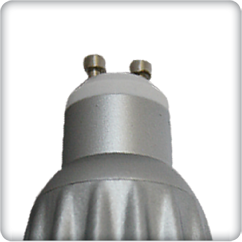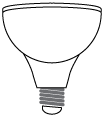How to choose the right LED bulb?
|
How much brightness do you need? |
When we only had incandescents it was enough to think about bulb brightness in terms of watts. Now we need to start thinking in lumens. Lumens (lm) measure light output.
The following table estimates how many lumens you get from your watts for different bulb technologies:
|
|
250 - 350 lm
|
400+ lm
|
700+ lm
|
900+ lm
|
1100+ lm
|
 Standard Standard |
25W | 40W | 60W | 75W | 100W |
| |
18W | 28W | 42W | 53W | 70W |
| |
6W | 9W | 12W | 15W | 20W |
| |
3 - 4W | 5 - 6W | 10W | 13W | 18W |
|
|
What fitting do you need? |
You can use our LED Bulbs and Spotlights with all your lamps – we have a wide range of fittings:
| E27 | E14 | Bougie E14 | GU10 |
 |
 |
 |
 |
| MR16 | G4 | G9 | AR111 |
 |
 |
 |
 |
| |
 |
Want a warmer or a cooler light? |
The temperature of light can be measured in terms of ‘Kelvin’. Very orange light has a low number of kelvin, a candle is about 1,500K. Day light is much cooler, above 4,000K. Here are the available options we offer:
Warm White (2700-3500K): This one most closely matches the color of incandescent light and is most used in the home to create a warm atmosphere.
Natural/Day White (4500K): This color of light is brighter white and does not have a yellow component feeling. It is typically used for office, retail, workshop lighting environments etc. A traditional fluorescent tube light normally emits light in this range. In a kitchen, bathroom or other situations you may prefer a slightly less yellow light and the natural white would be the perfect choice.
White/Cool White (6000K): This color of white light tends to have a bluish tone. Lights in this category are typically used in manufacturing and high brightness environments.
If your home has a quite modern style you should definitely consider trying some cooler temperatures (4500K or 6000K), as they can look great in the right context.
We will try to give you an idea of the atmosphere with different light colours on the following images:
|
Warm White Light - 2700-3000K Click here to view our range of |
Natural/Day White Light 4500K Click here to view our range of |
White/Cool Light 6000K Click here to view our range of |
 |
 |
 |
 |
Which shape do you need? |
Light bulbs are described by designated shape names and diameter/length codes. This usually takes a letter-number format. The letter(s) indicates the shape and the numbers indicate the diameter or the length of the bulb (in millimeters).
The shape of bulbs we offer:
| A series Standard |
C series Candle |
F series Flame |
G series Globe |
P series Pear |
PAR series |
R series Reflector |
T series Tubular |
R111 | PL |
 |
 |
 |
 |
 |
 |
 |
 |
 |
 |
Bulb shape is not just a question of liking the look of a bulb, it is about how it throws light. The design of the bulb determines what direction the light goes, so you need to consider what you want the bulb to do.
For a ceiling you might want an “arbitrary” shape. For a lamp you might need a candle shape with a broad spread. And if you are putting a spot into a recessed downlight you’ll need a reflector with an appropriate beam angle. The bulbs with wider beam angle light bigger areas while the LED spotlights highlight certain areas.
These are the beam angle options we offer: 20°, 25°, 32°, 38°, 40°, 110°, 120°, 150°, 160°, 180°, 195° , 200°, 270°, 300°.
Have a look at the images for a better idea:
light source

 |
Do you have dimmer switches? |
Some of our bulbs are dimmable – just look in the product description on the product information page online.
Click here to view all the dimmable LED bulbs we offer.

 +359 885 542 039
+359 885 542 039



















































































